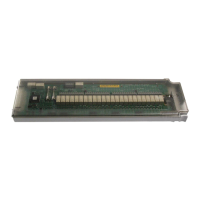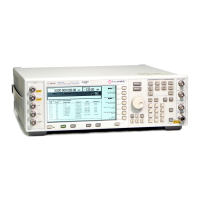1-54
Troubleshooting
Troubleshooting Assembly–Level Problems
1205 LB Pulse Mod
Lowband Pulse On
1. Disconnect the cable from J5 of A10 ALC, and connect the cable to a DVM (this is the lowband
detector output).
2. On the signal generator, set the following:
Center Frequency: 3 GHz
Power: +20 dBm
Pulse Modulation: On
Period: 40s
Pulse Width: 10 ns
RF: On
3. The voltage measured by the DVM should be approximately 0V. If it is not, use an oscilloscope to
view P131-6 of the A31 Motherboard (this is the pulse signal out of the A11 Pulse/Analog
Modulation Generator).
Change the pulse period to 1 ms and the pulse width to 500 µs.
• If the pulse is not present, perform the A11 Pulse/Analog Modulation Generator self–test,
and follow the troubleshooting procedure.
4. If pulse modulation is working, perform the A8 Output self–test.
• If the self–test passes, refer to “Troubleshooting the RF Path” on page 1-76, and check the
lowband path.
• If the self–test fails, refer to the A8 Output test troubleshooting.
Lowband Pulse Off
1. Disconnect the cable from J5 of A10 ALC, and connect the cable to a DVM (this is the lowband
detector output).
2. On the signal generator, set the following:
Center Frequency: 3 GHz
Power: +20 dBm
Pulse Modulation: On
Period: 40s
Pulse Width: 39.9s
RF: On
3. The voltage measured by the DVM should be approximately −2.2 V. If it is not, use an
oscilloscope to view P131-6 of the A31 Motherboard (this is the pulse signal out of the A11
Pulse/Analog Modulation Generator).
Change the pulse period to 1 ms and the pulse width to 500 µs.
• If the pulse is not present, perform the A11 Pulse/Analog Modulation Generator self–test,
and follow the troubleshooting procedure.
4. If pulse modulation is working, perform the A8 Output self–test.
• If the self–test passes, refer to “Troubleshooting the RF Path” on page 1-76, and check the
lowband (<3.2 GHz) path.
• If the self–test fails, refer to the A8 Output test troubleshooting.

